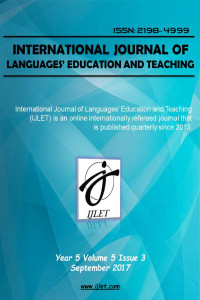Assessment of Teaching Strategies, Classroom Interaction and Teacher Concerns in the Implementation of Large Class Policy on a Speech Communication Course
Öz
This study aimed to identify the teaching strategies used in the classroom and concerns of teachers in the implementation of large class policy. This study also looked at the perception of teachers in their interaction with their students as well as the perception of students at their teacher’s interaction with them. The six speech communication lecturers and 716 undergraduate students in the 2nd semester of 2014-2015 were the participants of the study. Researchers asked teacher respondents to fill out several questionnaires to identify large class-teaching strategies, gauge teacher-student interaction in large classes and determine personal concerns. One-on-one interview with the teacher respondents was also done to validate the results obtained from surveys. Moreover, they also asked students to fill out the Questionnaire on Teacher Interaction (QTI) to determine their perception of teacher’s interaction in the classroom. The teachers revealed their various large class teaching strategies, the most common of which is the discussion type. Teachers’ perceived classroom interaction with their students were in agreement with that of their students giving higher scores in the types depicting positive interpersonal behavior like leadership and helpfulness and lower scores in the types depicting negative behavior such as dissatisfaction and admonition. Based from the one-on-one interviews, teacher respondents felt lesser interaction with students in the large lecture class compared to the previous small classroom set-up. Results from teachers’ stages of concern profile showed that they were unconcerned on the implementation of large class policy. Some expressed their strong opposition on the policy and had other educational changes in mind that competed for their attention at the time of the study. There were also issues on credit loading and collaboration with recitation teachers raised during interviews.
Anahtar Kelimeler
Large class policy teaching strategies classroom interaction teacher concerns speech communication
Kaynakça
- Amatari, V. O. (2015). The Instructional Process: A Review of Flanders’ Interaction Analysis in a Classroom Setting. International Journal of Secondary Education, 3(5), 43-49. doi:doi: 10.11648/j.ijsedu.20150305.11
- Altbach, P., Reisberg, L., & Rumbley, L. E. (2009). Trends in Global Higher Education:Tracking an Economic Revolution. UNESCO. France: UNESCO. Retrieved from http://www.uis.unesco.org/Library/Documents/trends-global-higher-education-2009-world-conference-en.pdf
- Benbow, J., Mizrachi, A., Oliver, D., & Said Moshiro, L. (2007). Large Class Sizes in the Developing World: What do we Know and What Can We Do? Retrieved from USAID US Agency for International Development.
- Cinco, M., & Coling-Pulumbarit, C. (2010). At UP Los Baños: Mga Iskolar ng Bayan walk out of their classes to protest the large class policy. Laguna. Retrieved from http://www.arkibongbayan.org/2010/2010-01Jan29-UPLB%20walkout/uplb%20vs%20large%20class%20policy.htm
- Cuseo, J. (2007). The Empirical Case Against Large Class Size: Adverse Effects on the Teaching, Learning and Retention of First-Year College Students. Marymount University. Retrieved from http://www.classsizematters.org/wp-content/uploads/2012/11/Week-13-Cuseo-1.pdf
- Fisher, D., Fraser, B., & Cresswell, J. (1995). Using the "Questionnaire for Teacher Interaction" in the Professional Development of Teachers. Australian Journal of Teacher Education, 2. Australia.
- George, A. A., Hall, G. E., & Stiegelbauer, S. M. (2006). Measuring Implementation in Schools: The Stages of Concern Questionnaire. Austin, Texas: SEDL Publishing.
Assessment of Teaching Strategies, Classroom Interaction and Teacher Concerns in the Implementation of Large Class Policy on a Speech Communication Course
Öz
Kaynakça
- Amatari, V. O. (2015). The Instructional Process: A Review of Flanders’ Interaction Analysis in a Classroom Setting. International Journal of Secondary Education, 3(5), 43-49. doi:doi: 10.11648/j.ijsedu.20150305.11
- Altbach, P., Reisberg, L., & Rumbley, L. E. (2009). Trends in Global Higher Education:Tracking an Economic Revolution. UNESCO. France: UNESCO. Retrieved from http://www.uis.unesco.org/Library/Documents/trends-global-higher-education-2009-world-conference-en.pdf
- Benbow, J., Mizrachi, A., Oliver, D., & Said Moshiro, L. (2007). Large Class Sizes in the Developing World: What do we Know and What Can We Do? Retrieved from USAID US Agency for International Development.
- Cinco, M., & Coling-Pulumbarit, C. (2010). At UP Los Baños: Mga Iskolar ng Bayan walk out of their classes to protest the large class policy. Laguna. Retrieved from http://www.arkibongbayan.org/2010/2010-01Jan29-UPLB%20walkout/uplb%20vs%20large%20class%20policy.htm
- Cuseo, J. (2007). The Empirical Case Against Large Class Size: Adverse Effects on the Teaching, Learning and Retention of First-Year College Students. Marymount University. Retrieved from http://www.classsizematters.org/wp-content/uploads/2012/11/Week-13-Cuseo-1.pdf
- Fisher, D., Fraser, B., & Cresswell, J. (1995). Using the "Questionnaire for Teacher Interaction" in the Professional Development of Teachers. Australian Journal of Teacher Education, 2. Australia.
- George, A. A., Hall, G. E., & Stiegelbauer, S. M. (2006). Measuring Implementation in Schools: The Stages of Concern Questionnaire. Austin, Texas: SEDL Publishing.
Ayrıntılar
| Birincil Dil | İngilizce |
|---|---|
| Konular | Dil Çalışmaları (Diğer), Uygulamalı Dilbilim ve Eğitim Dilbilimi |
| Bölüm | Araştırma Makalesi |
| Yazarlar | |
| Yayımlanma Tarihi | 30 Eylül 2017 |
| Yayımlandığı Sayı | Yıl 2017 Cilt: 5 Sayı: 3 |


